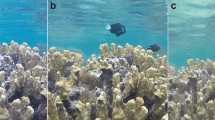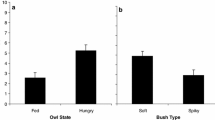Summary
In controlled experiments, shoaling European minnows fed in equal numbers on two equally-rewarded food patches, and likewise on unequal patches the numbers feeding reflected food levels. For equal food, minnows did not feed at the patch where they had encountered a simulated diving avian predator, whereas they chose to feed at this risky patch when it was more valuable. By avoiding hazard for equal food, but accepting predator risk for higher food rewards, the minnows performed a risk-balancing trade-off.
Similar content being viewed by others
References
Cerri RD, Fraser DF (1983) Predation and risk in foraging minnows: balancing conflicting demands. Am Nat 121:552–561
Dill LM (1983) Adaptive flexibility in the foraging behaviour of fishes. Can J Fish Aquat Sci 40:398–408
Grubb TC, Greenwald L (1982) Sparrows and brushpile: foraging responses to different combinations of predation risk and energy cost. Anim Beh 30:637–640
Fraser DF, Huntingford FA (1986) Feeding and avoiding predation hazard: the behavioural response of the prey. Ethology 73:56–68
Fretwell SD, Lucas HL (1970) On territorial behaviour and other factors influencing habitat distribution in birds. Acta Biotheoret 19:16–36
Godin J-GJ, Keenleyside MHA (1984) Foraging on patchily distributed prey by a cichlid fish: a test of the ideal free distribution theory. Anim Behav 32:120–131
Hart PJB (1986) Foraging in teleost fishes. In: Pitcher TJ (ed) The behaviour of teleost fishes. Croom Helm, London, pp 211–252
Huntingford FA, Giles N (1987) Individual variation in antipredator responses in the three-spined stickleback (Gasterosteus aculeatus L.). Ethology 74:205–210
Magurran AE (1986) Predator inspection behaviour in minnow shoals: differences between populations and individuals. Behav Ecol Sociobiol 19:267–273
Magurran AE, Higham A (1988) shoaling fish obtain information about a predator's approach from changes in the behaviour of other shoal members. Ethology (in press)
Magurran AE, Oulton W, Pitcher TJ (1985) Vigilant behaviour and shoal size in minnows. Z Tierpsychol 67:167–178
Magurran AE, Pitcher TJ (1983) Foraging, timidity and shoal size in minnows and goldfish. Behav Ecol Sociobiol 12:142–152
Magurran AE, Pitcher TJ (1987) Provenance, shoal size and the sociobiology of predator evasion behaviour in minnow shoals. Proc Roy Soc London B 229:439–465
Milinski M (1984) Competitive resource sharing: an experimental test of a learning rule for ESSes. Anim Behav 32:233–242
Milinski M (1985a) Risk of predation taken by parasitised sticklebacks under competition for food. Behaviour 93:203–216
Milinski M (1985b) The patch choice model: no alternative to balancing. Am Nat 125:317–320
Milinski M (1986) Constraints placed by predators on feeding behaviour. In: Pitcher TJ (ed) The behaviour of teleost fishes. Croom Helm, London, pp 236–252
Milinski M (1987) Tit-for-tat in sticklebacks and the evolution of cooperation. Nature 325:433–437
Parker GA, Sutherland WJ (1986) Ideal-free distributions when individuals differ in competitive ability. Anim Behav 34:1222–1242
Pitcher TJ (1980) Some ecological consequences of fish school volumes. Freshwater Biology 10:539–544
Pitcher TJ (1986) The functions of shoaling behaviour. In: Pitcher TJ (ed) The behaviour of teleost fishes. Croom Helm, London, pp 294–337
Pitcher TJ, House AC (1988) Foraging rules for group feeders: area copying depends upon food density in shoaling goldfish. Ethology 76:161–167
Pitcher TJ, Green DA, Magurran AE (1986) Dicing with death: predator inspection behaviour in minnow shoals. J Fish Biol 28:438–448
Sih A (1980) Optimal foraging: can foragers balance two conflicting demands? Science 210:1041–1043
Sokal RR, Rohlf FJ (1981) Biometry, Freeman, San Francisco
Sutherland WS (1983) Aggregation and the ‘ideal free distribution’. J Anim Ecol 52:821–828
Author information
Authors and Affiliations
Rights and permissions
About this article
Cite this article
Pitcher, T.J., Lang, S.H. & Turner, J.A. A risk-balancing trade off between foraging rewards and predation hazard in a shoaling fish. Behav Ecol Sociobiol 22, 225–228 (1988). https://doi.org/10.1007/BF00300573
Received:
Accepted:
Issue Date:
DOI: https://doi.org/10.1007/BF00300573




